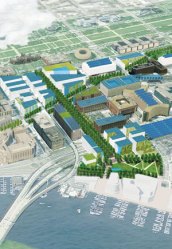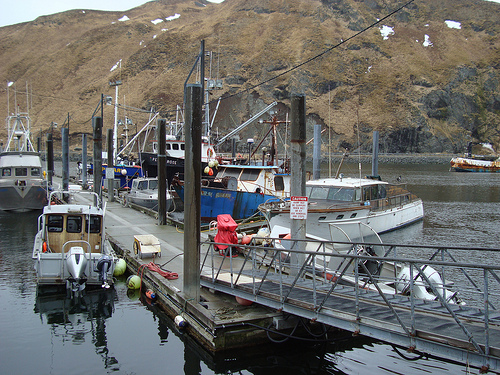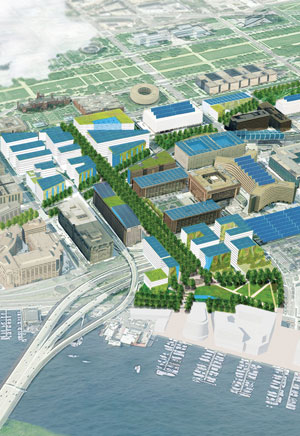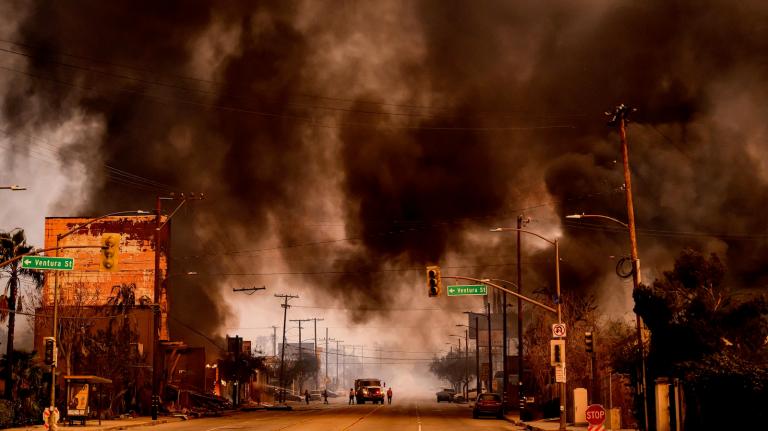 After two years of internal debate among 17 different federal agencies and the Washington, D.C., government, the National Capital Planning Commission (NCPC) released its long-awaited plans for a new Southwest Eco-District this week. The plan is designed to undo the worst damage of the massive “urban renewal” projects inflicted on L’Enfant neighborhood over the past decades. When it is completed, still decades out, it will transform the spooky, almost pedestrian-free area just south of the National Mall into a highly sustainable, people-friendly cultural and business destination.
After two years of internal debate among 17 different federal agencies and the Washington, D.C., government, the National Capital Planning Commission (NCPC) released its long-awaited plans for a new Southwest Eco-District this week. The plan is designed to undo the worst damage of the massive “urban renewal” projects inflicted on L’Enfant neighborhood over the past decades. When it is completed, still decades out, it will transform the spooky, almost pedestrian-free area just south of the National Mall into a highly sustainable, people-friendly cultural and business destination.
The project will go a long way toward “breathing new life into the city,” NCPC Chair L. Preston Bryant, Jr. said at a hearing Thursday. “We have a once in a generation opportunity to make this happen.”
The 110-acre, 15 square-block project is meant to showcase “high performance buildings and landscapes,” while creating space for 19,000 new federal workers, says Elizabeth Miller, the landscape architect who is guiding the project. At the same time, the plan will take aim at the incredible lack of public access — the barriers, the highways, and grade changes — that keep people away.
Diane Sullivan, sustainability planner for NCPC, says the goal is to create a new tree-lined 10th street (or L’Enfant Place) that can connect the Mall to the new southwest waterfront development while also making that connection itself an exciting cultural destination, with space for up to five new museums, along with farmers markets and other draws.
To improve pedestrian access, Miller says new, park-like avenues will carve through the buildings, cutting up the impenetrable “mega-blocks.” A revamped, solar roofed-L’Enfant station will offer access via both commuter rail and Metro. A nearby freeway will be capped with a solar-panel skinned shell, connecting Benjamin Banneker Park, which serves as a monument to an African American surveyor, to the waterfront.
Miller says the new district will “capture, manage, and reuse water, energy, and waste,” integrating clusters of buildings to create a new system. Many of the old federal buildings will be replaced by new ones that meet the goals of Obama’s Executive Order 13514, which calls for federal agencies to reduce greenhouse gas emissions, water and energy use. The ones that stay, like the famed Brutalist HUD building, will be updated to be more efficient.
Sullivan says the goal is to create a “zero-net energy district as measured in carbon.” Solar electric and hot water systems will be added to the roofs of the new buildings wherever possible, while ground-source heat will also be tapped. A central facility that runs on natural gas will still be used.
The plan also sets out to reduce potable water use throughout the eco-district by 70 percent and manage all stormwater where it falls. All building greywater will be reused while blackwater will go to a new anaerobic treatment plant. Rainwater will be caught by acres of green roofs (including rooftop farms), green streets, trees, and planters. Permeable surfaces will grow to cover 35 percent of the area, while the tree canopy will reach 40 percent.
There are more ambitious goals for waste reduction: Some 75 percent of construction materials for the new buildings will be reused, and 80 percent of everyday waste will be diverted from the landfill. A composting program will be put in place, too.
So, how will this all actually work? Sullivan sees some government buildings first getting a light rehabilitation and then others will undergo a full rehabilitation. Three federal buildings will be “re-purposed” as major infill development begins. Then, big redevelopment will start over the freeway. Critical projects like a new Banneker Park and a new 10th street landscape will begin next year.
What’s this all going to cost? An economic feasibility study only provided some high-level numbers, but Miller and Sullivan say the federal government will make back its multibillion dollar investment over 20 years through reduced energy, water, and waste fees; increased revenues from private sector developers; and improved local tax gains.
Learn more about the plans here, and read more about eco-districts here.



